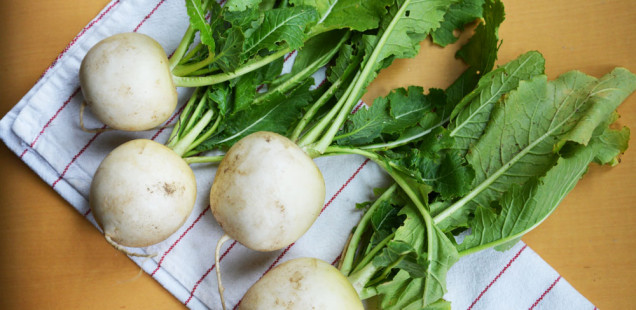All About Hakurei Turnips
The turnip, that root vegetable with the bulbous white taproot, has been cultivated by humans for at least thirty-five centuries. And although often forgotten in modern diets, it holds quite a distinguished place in the history of European civilization—considered to be a vegetable of nobility, the turnip was prominently featured in the coat of arms of more than a few royal families and townships. The Hakurei is a relatively new variety developed in Japan in the mid-twentieth century and renowned for its delicate, fruity flavor.
In season: autumn, winter.
Trivia
- In traditional Celtic festivals, turnips were hollowed out and transformed into lanterns, much as pumpkins are for modern-day Halloween celebrations.
- Are you convinced turnips are inedibly bitter? It might be genetic. Like its cousin rutabaga, turnips contain bitter chemicals called cyanoglucosides. Your sensitivity to these chemicals is determined by a pair of your genes, and whether or not you inherited the version sensitized to cyanide. It’s like the cilantro syndrome!
- The turnip’s root is chock full of vitamin C. (Small wonder that turnips are traditionally used as a cure for the common cold in many parts of the world!) The leaves are a good source of vitamins too: A, C, and K, as well as folate and calcium.
Storage
As soon as you bring turnips home, cut the greens from the roots. The roots will store well for a week to ten days, and they do best very cold and at high humidity. The green leaves can be stored separately in a plastic bag, and should be used as soon as possible, as they tend to lose their nutritional contents quickly after harvest.
Cooking Lore
The Hakurei turnip’s skin is tender, and doesn’t need to be peeled. Both roots and leaves should be washed well just before using. The turnip greens are similar to mustard greens in flavor, and can be used as any other hearty winter green.
The Hakurei turnip root is sweet and crunchy as it is, raw. Try it shaved in a salad, sliced in wedges with crudite, or slightly pickled in a bowl of cold water with a touch of salt and vinegar. When cooked, the turnip’s sweetness intensifies, and a delicious butter flavor emerges. Turnips are excellent in gratins, stews, and soups, or simply roasted with a pinch of salt and a little oil.
